Choosing a crib is one of the most important steps in preparing for the arrival of a baby. This purchase directly impacts the safety, comfort, and sleep quality of your child. In this article, we’ll discuss how to avoid mistakes when selecting a crib and create the best conditions for your baby’s rest.
Materials and Construction: The Key to Safety
Start by evaluating the materials the crib is made from.
Wood or Metal
Wood is considered the most popular and safest option. Prioritize hypoallergenic wood types such as beech, birch, or pine. Ensure the wood is treated with safe paints or varnishes that do not emit toxic substances—this is important because babies tend to chew on wooden surfaces.
Another option is metal cribs. They are sturdy and durable, but make sure the coating is high-quality and free of rust or peeling paint.
Crib Construction
Pay attention to the following aspects when assessing the crib’s construction:
- Sturdy joints. The crib should not wobble or squeak. All parts must be securely fastened.
- Rounded edges. All corners and edges should be smooth to prevent cuts or bruises.
- Adjustable mattress height. The ability to change the mattress level is essential for adapting the crib as your child grows. A higher setting is convenient for newborns, while a lower one is safer for babies who start pulling themselves up.
Mattress and Bedding: Creating Comfort
The quality of the mattress plays a crucial role in ensuring the safety and health of your baby.
Key Requirements for the Mattress
The mattress should be firm enough to support the baby’s spine. A mattress that is too soft can pose a suffocation risk, especially for newborns.
It should fit snugly into the crib without leaving gaps between the mattress and the crib walls. Choose mattresses made from natural materials such as coconut fiber or latex. Verify that the materials are certified for safety.
Bedding
When it comes to bedding, minimalism is key to safety. Avoid extra items like pillows, blankets, toys, or soft bumpers in the crib. For infants, a sleeping bag is the ideal choice as it eliminates the risk of obstructed breathing.
Safety Certifications and Standards: A Vital Step Before Purchase
Ensure the crib is certified to meet international safety standards.
International Standards
The European standard EN 716 guarantees that the crib has been tested for durability, stability, and the absence of hazardous elements. The American standard ASTM ensures the safety of the crib’s construction and materials.
Certifications confirm that the crib has undergone tests for resistance to mechanical damage, sharp elements, and toxic substances. If a crib lacks certification, it’s better to avoid the purchase, even if the price seems attractive.
Design and Functionality: Added Benefits
Many modern cribs include features that make parents’ lives easier. However, not all of them are necessary or safe.
Convertible Cribs
These cribs can be transformed into a toddler bed or a desk. While practical, ensure that the conversion mechanism is secure and reliable.
Rocking Mechanisms
Cribs with rocking functions make it easier to soothe a baby, but the mechanism should be stable and equipped with a locking system.
Drawers
Drawers underneath the crib are convenient for storage, but ensure they do not compromise the crib’s stability.
Also, consider the size of the crib. Standard sizes are 120 × 60 cm or 140 × 70 cm. Larger cribs are suitable if you plan to use them for several years.
Other Considerations
If you’re considering a second-hand crib, ensure it is in perfect working condition and complies with current safety standards. Check that all fastenings are secure and the materials are intact.
Cribs with wheels can be practical if you plan to move them. However, make sure the wheels have a locking mechanism.
The crib should allow for good airflow. Open side panels are the best choice.
Common Mistakes to Avoid
- Avoid overly cheap models. Low prices often mean poor-quality materials and construction.
- Don’t add unnecessary accessories. Pillows, bumpers, and soft toys can pose a danger to infants.
- Regularly check the crib’s condition. Over time, fastenings can loosen, and paint or varnish may become damaged.
Remember, your child’s safety is your top priority. A well-chosen crib will be a cozy and secure place where your baby can grow and thrive.


